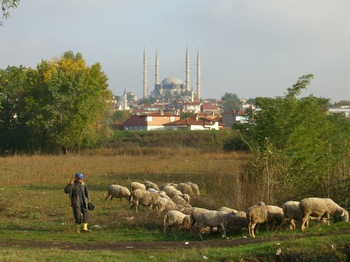April in ‘Stambul,’ what a lovely site it is as the city prepares for 2010, then designated the CULTURAL CAPITAL of EUROPE. The variety of tulips newly planted in a wild array of color dazzles the eye causing excitement, wonder and expectation of more as one whisks along toward the hotel. Those staying in the Sultanahmet area notice the hippodrome and environs are also clothed in exotic hues, more so than previous years. From the fringed to the multi-colored, the historian is reminded that the tulip was taken to Europe by diplomats who fell in love with them too. Ongoing renovations also greet the visitor with the closing of some sites, but fortunately, not the popular ones. Such an ancient place has seen many changes over the years.
Due to family illness, my trip to Mimar Sinan’s birthplace was postponed, but I did have the opportunity to experience anew my favorite city while guiding friends on their very first adventure to the ancient capital. This even provided opportunities to see some new sites such as the Yedikule.
The station of Cankurtaran, just below Sultanahmet, has commuter trains running often for a quick trip to the towers where the Theodosian wall begins its journey north to the Golden Horn. The damage from the railway built right through the wall fortunately did not hurt the towers which are a bit further from the shore. Suffering from many battles and a multitude of earthquakes over the centuries, these large structures still stand majestically.
One can spend a long time investigating the remnants of history found in the buildings, but we chose to walk along the west side of the walls. Here the imagination runs wild with what Constantinople might have looked like those many years ago for all along the wall’s edge are various vegetable gardens with their accompanying houses. The horse carts, children playing and people tending the fields are just a hint of the old life, and picturesque for the city dweller. Any gate through the wall provides a way to head back “home,” and an enjoyable walk in the small streets with the possibility of stopping for a refreshing beverage or a bite to eat. A map is necessary to find the tram because it is a long walk but fun for those in shape.
Before my travels to The City, I had noticed an article about Les Arts Turcs. This organization run by Nurdoğan Şengüler and Alp Akşahin promotes the various arts of Turkey whether it be painting, music, food or the many others, and have various tours and activities. Their doors are open to everyone including the foreigner, and they give suggestions to those seeking help on various matters. At the moment Les Arts Turcs has a photo contest; they are looking for the best pictures of Istanbul. With next years winners included, they will choose the top 100 for display when İstanbul is the Cultural Capital of Europe. They also hope to have them published in a small book available at the same time. Check them out at www.lesartsturcs.com for more information.



 Posted by sinandiarys
Posted by sinandiarys 

